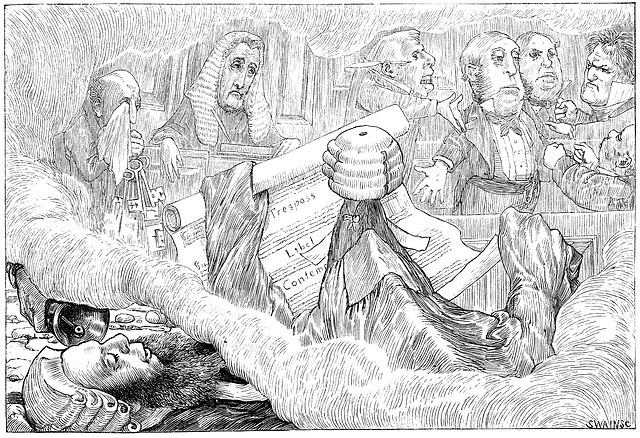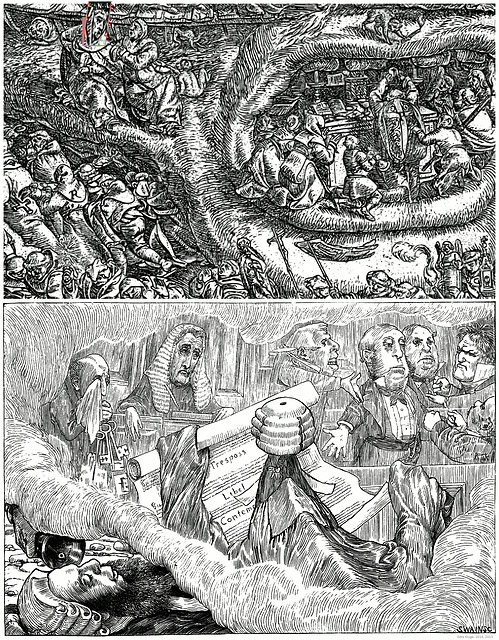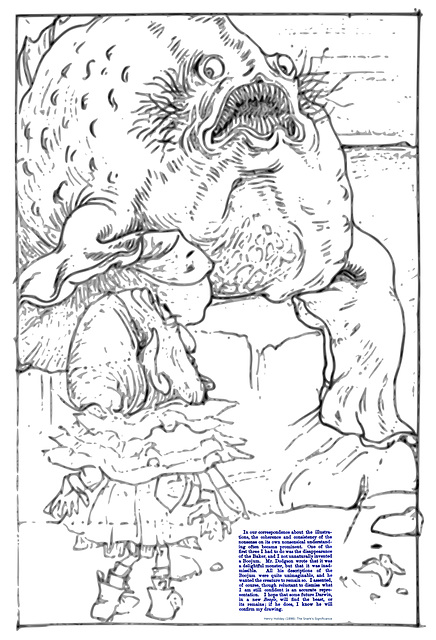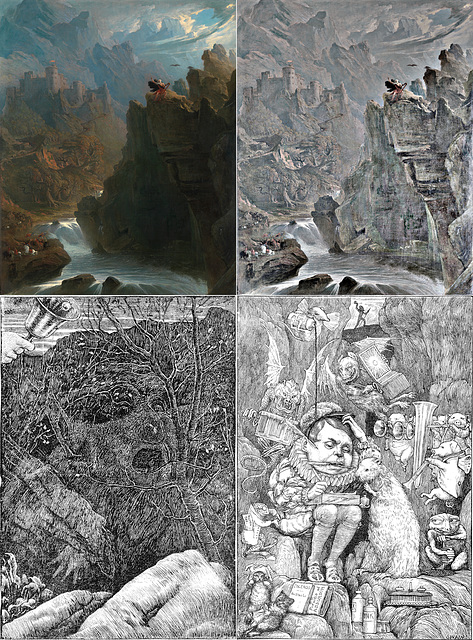
The Snark
Folder: The Hunting of the Snark
26 Jun 2011
3 comments
h60
From Henry Holiday's illustrations to Lewis Carroll's The Hunting of the Snark (1876)
Very large version: www.ipernity.com/doc/goetzkluge/37780784
23 Jun 2013
5 comments
The Snark in your Dreams
The lower image is the only Snark illustration by Henry Holiday which shows the Snark . However, in this case the beast appeared in The Barrister's dream . Therefore it is just a Dream Snark .
[top]: Detail from the etching (1566-1568) The Image Breakers by Marcus Gheeraerts the Elder.
[bottom]: Detail from the illustration (1876) by Henry Holiday to The Hunting of the Snark . Lewis Carroll (C. L. Dodgson) did not want Henry Holiday to depict the Snark in the illustrations to The Hunting of the Snark . But Holiday was allowed to let it appear veiled by its "gown, bands, and wig" in The Barrister's Dream .
Also in this case, Holiday pictorially alluded to the etching by Marcus Gheeraerts the Elder. In this comparison several shapes - see notes (1) to (5) - provide the beholder of the illustration with pictorial quotes which point to that etching.
This is just the place to repeat a textual quote which I like a lot:
"We have neglected the gift of comprehending things through our senses. Concept is divorced from percept, and thought moves among abstractions. Our eyes have been reduced to instruments with which to identify and to measure; hence we suffer a paucity of ideas that can be expressed in images and in an incapacity to discover meaning in what we see. Naturally we feel lost in the presence of objects that make sense only to undeluted vision, and we seek refuge in the more familiar medium of words. ... The inborn capacity to understand through the eyes has been put to sleep and must be reawakened."
(Rudolf Arnheim: Art and Visual Perception, 1974, p. 1)
Images like this could be used in class by arts teachers to reawaken that inborn capacity. This also is a training to make and discuss decisions based on incomplete information.
Am I wrong? Am I right?
"Only those questions that are in principle undecidable, we can decide."
(Heinz von Foerster: Ethics and Second-Order Cybernetics, 1990-10-04, Système et thérapie familiale, Paris)
·
2014-05-19
18 May 2014
3 comments
Carroll's Barrister's Dream
Redrawn image from a concept draft by C.L. Dodgson (aka Lewis Carroll). The original drawing was part of a lot consisting of an 1876 edition of the "Hunting of the Snark" and a letter (dated 1876-01-04) by Dodgson to Henry Holiday. The lot was auctioned by Doyle New York (Rare Books, Autographs & Photographs - Sale 13BP04 - Lot 553) offered in November 2013. The whole lot was sold for US$ 25000.
www.doylenewyork.com/asp/fullcatalogue.asp?salelot=13BP04+++553+&refno=++953647&image=2
Henry Holiday's depiction of a scene from the chapter "The Barrister's dream".
19 May 2014
1 favorite
4 comments
Dream Snarks
[top]: Detail from the etching (1566-1568) The Image Breakers by Marcus Gheeraerts the Elder.
[center]: Detail from the illustration (1876) by Henry Holiday to The Hunting of the Snark . C. L. Dodgson did not want Henry Holiday to depict the Snark in the illustrations to The Hunting of the Snark . But Holiday was allowed to let it appear veiled by its "gown, bands, and wig" in The Barrister's Dream .
[bottom]: Redrawn image from a concept draft by C. L. Dodgson (aka Lewis Carroll). The original drawing was part of a lot consisting of an 1876 edition of The Hunting of the Snark and a letter (dated 1876-01-04) by Dodgson to Henry Holiday. The lot was auctioned by Doyle New York (Rare Books, Autographs & Photographs - Sale 13BP04 - Lot 553) offered in November 2013. The whole lot was sold for US$ 25000. ( www.doylenewyork.com/asp/fullcatalogue.asp?salelot=13BP04+++553+&refno=++953647&image=2 )
·
This shows: First C. L. Dodgson defined the concept [bottom], then Henry Holiday did the artwork (including the allusions to Gheeraert's "head" [top]) and finally Joseph Swain cut the illustration [center] into a woodblock.
30 Jul 2013
1 favorite
5 comments
The Boojum sitting on some of the 42 boxes
1875: Proposal for a depicton of a Boojum turned Snark by Henry Holiday (and redrawn by me) to Lewis Carroll. However, Carroll (Dodgson) preferred to leave it to the imagination of his readers (and to the imagination of the Barrister ) how the Snark may look like.
The little vanishig guy is The Baker . Does the Boojum sit on some of the Baker's 42 boxes?
It is said that Carroll "suppressed" Holiday's Boojum, but I think that between these two gentlemen that is not the right term.
"[...] One of the first three [illustrations] I had to do was the disappearance of the Baker , and I not unnatuarally invented a Boojum. Mr. Dodgson wrote that it was a delightful monster, but that it was inadmissible. All his descriptions of the Boojum were quite unimaginable, and he wanted the creature to remain so. I assented, of course, though reluctant to dismiss what I am still confident is an accurate representation. I hope that some future Darwin in a new Beagle will find the beast, or its remains; if he does, I know he will confirm my drawing. [...]"
(Source: Henry Holiday (1898): The Snark's Significance )
Did Henry Holiday's Boojum turned Snark sit on the Baker's boxes?
From a sketch by H. Holiday and a painting by J. E. Millais:
13 Mar 2016
2 favorites
5 comments
J. J. Grandville's Monsters
(Vectorized image from a 19th century book)
Thanks to John Tufail (one of the few more curageous Snark hunters) for discovering the similarity to Henry Holiday's Boojum.
04 Sep 2014
1 favorite
2 comments
John Martin's Bard and Henry Holiday's Snark Illustrations
top left: John Martin, The Bard (1817).
top right: John Martin, The Bard modified using GIMP, Retinex: Scale=160, ScaleDivision=6, Dynamic=2.5
bottom left: Illustration (1876) by Henry Holiday to Lewis Carroll's The Hunting of the Snark , Fit 8. Changes: GIMP "delate" applied in order to yield a less darker printing.
bottom right: Illustration (1876) by Henry Holiday to Lewis Carroll's The Hunting of the Snark , Fit 5
4800 px × 6500 px
20.3 cm × 27.5 cm (@ 600 dpi)
=====================================================
John Martin: The Bard
ca. 1817
Yale Center for British Art, Paul Mellon Collection
collections.britishart.yale.edu/vufind/Record/1671616 :
"Based on a Thomas Gray poem, inspired by a Welsh tradition that said that Edward I had put to death any bards he found, to extinguish Welsh culture; the poem depicts the escape of a single bard.
In mydailyartdisplay.wordpress.com/the-bard-by-john-martin , "Jonathan" connects the painting to the poem The Bard written by by Thomas Gray in 1755:
· · ...
· · On a rock, whose haughty brow
· · Frowns o'er cold Conway's foaming flood,
· · Robed in the sable garb of woe
· · With haggard eyes the Poet stood;
· · ...
· · "Enough for me: with joy I see
· · The diff'rent doom our fates assign.
· · Be thine Despair and sceptred Care;
· · To triumph and to die are mine."
· · He spoke, and headlong from the mountain's height
· · Deep in the roaring tide he plunged to endless night.
· · ...
The poem and the painting may have been an inspiration to Lewis Carroll and Henry Holiday in The Hunting of the Snark:
· · 545 · · Erect and sublime, for one moment of time.
· · 546· · · · In the next, that wild figure they saw
· · 547· · (As if stung by a spasm) plunge into a chasm,
· · 548· · · · While they waited and listened in awe.
Album:
John Martin
01 May 2016
3 comments
Thomas Cranmer's Boojum (with inset)
·
See also: www.academia.edu/9918883/Thomas_Cranmers_42_Boxes
The upper left image is a detail lfrom a print (c. 1630) which shows the burning of Thomas Cranmer.
The lower left is a +135° rotated detail from Henry Holiday's illustration (large image on the right side) to the final chapter The Vanishing in Lewis Carroll's The Hunting of the Snark ,
In The annotated ... Snark , Martin Gardner wrote about Henry Holiday's illustration to the last chapter of Carroll's The Hunting of the Snark : "Thousands of readers must have glanced at this drawing without noticing (though they may have shivered with subliminal perception) the huge, almost transparent head of the Baker, abject terror on his features, as a giant beak (or is it a claw?) seizes his wrist."
I think, there is neither a beak nor a claw.
About The Baker :
· · · · 021 · · There was one who was famed for the number of things
· · · · 022 · · · · He forgot when he entered the ship:
· · · · 023 · · His umbrella, his watch, all his jewels and rings,
· · · · 024 · · · · And the clothes he had bought for the trip.
· · · · 025 · · He had forty-two boxes , all carefully packed,
· · · · 026 · · · · With his name painted clearly on each:
· · · · 027 · · But, since he omitted to mention the fact,
· · · · 028 · · · · They were all left behind on the beach.
· · · · 029 · · The loss of his clothes hardly mattered, because
· · · · 030 · · · · He had seven coats on when he came,
· · · · 031 · · With three pairs of boots --but the worst of it was,
· · · · 032 · · · · He had wholly forgotten his name.
· · · · 033 · · He would answer to "Hi!" or to any loud cry,
· · · · 034 · · · · Such as " Fry me! " or " Fritter my wig! "
· · · · 035 · · To "What-you-may-call-um!" or "What-was-his-name!"
· · · · 036 · · · · But especially "Thing-um-a-jig!"
· · · · 037 · · While, for those who preferred a more forcible word,
· · · · 038 · · · · He had different names from these:
· · · · 039 · · His intimate friends called him " Candle-ends ,"
· · · · 040 · · · · And his enemies " Toasted-cheese ."
· · · · 041 · · "His form is ungainly--his intellect small--"
· · · · 042 · · · · (So the Bellman would often remark)
· · · · 043 · · "But his courage is perfect! And that, after all,
· · · · 044 · · · · Is the thing that one needs with a Snark."
· · · · 045 · · He would joke with hyenas, returning their stare
· · · · 046 · · · · With an impudent wag of the head :
· · · · 047 · · And he once went a walk, paw-in-paw, with a bear ,
· · · · 048 · · · · "Just to keep up its spirits," he said.
· · · · 049 · · He came as a Baker: but owned, when too late--
· · · · 050 · · · · And it drove the poor Bellman half-mad--
· · · · 051 · · He could only bake Bridecake--for which, I may state,
· · · · 052 · · · · No materials were to be had.
That is, there were no brides in the crew.
Sources:
www.ipernity.com/doc/goetzkluge/19289289
www.britishmuseum.org/research/collection_online/collection_object_details.aspx?objectId=3066133&partId=1&people=122781&peoA=122781-1-9&page=1
luna.folger.edu/luna/servlet/detail/FOLGERCM1~6~6~810509~152457:Faiths-victorie-in-Romes-crueltie--
Jump to top
RSS feed- Latest items - Subscribe to the latest items added to this album
- ipernity © 2007-2024
- Help & Contact
|
Club news
|
About ipernity
|
History |
ipernity Club & Prices |
Guide of good conduct
Donate | Group guidelines | Privacy policy | Terms of use | Statutes | In memoria -
Facebook
Twitter










